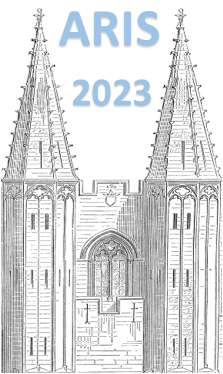Orateur
Description
Shell evolution in the region around the magic numbers $N=28$ and $Z=20$ is of great interest in nuclear structure physics. Moving away from the doubly-magic isotope $^{48}$Ca, in the neutron-rich direction there is evidence of an emergent shell gap at $N=34$ [1], and in the proton-deficient direction, the onset of shape deformation suggests a weakening of the $N=28$ magic number [2]. The $^{47}$K(d,p)$^{48}$K reaction is uniquely suited to investigating this region, as the ground state configuration of $^{47}$K has an exotic proton structure, with an odd proton in the $\pi(1s_{1/2})$ orbital, below a fully occupied $\pi(0d_{3/2})$ orbital [3]. As such, the selective neutron transfer reaction (d,p) will preferentially populate states in $^{48}$K arising from $\pi(1s_{1/2}) \otimes \nu(fp)$ cross-shell interactions. The implications of this extend both down the proton-deficient $N=28$ isotonic chain, where these interactions are expected to dominate the structure of the exotic, short-lived $^{44}$P nucleus [4], and across the neutron-rich region, where the relative energies of the $\nu(fp)$ orbitals is the driving force behind shell evolution.
The first experimental study of states arising from the interaction between $\pi(1s_{1/2})$ and the orbitals $\nu(1p_{3/2})$, $\nu(1p_{1/2})$ and $\nu(0f_{5/2})$ has been conducted, by way of the $^{47}$K(d,p) reaction in inverse kinematics. A beam of radioactive $^{47}$K ions was delivered by the GANIL-SPIRAL1+ facility, with a beam energy of 7.7 MeV/nucleon. This beam was estimated to be $>99.99$% pure, with a typical intensity of $5\times10^{5}$ pps, and was impinged upon a 0.3 mg/cm$^2$ CD$_2$ target. The MUGAST+AGATA+VAMOS detection setup [5] allowed for triple coincidence gating, providing a great amount of selectivity. An analysis based both on excitation and gamma-ray energy measurements has revealed a number of previously unobserved states in $^{48}$K, and preliminary differential cross sections for the most strongly populated of these states will be presented. Spectroscopic factors for these states will be discussed in the context of shell model calculations, with regard to the N=28, 32 and 34 shell gaps. Additionally, results for positive and negative parity states in $^{46}$K, measured simultaneously via the $^{47}$K(d,t) reaction, will also be presented.
[1] D. Steppenbeck et al., Nature 502, 207 (2013).
[2] O. Sorlin and M.-G. Porquet, Prog. Part. Nucl. Phys. 61, 602 (2008).
[3] J. Papuga et al., Phys. Rev. C, 90 034321 (2014).
[4] L. Gaudefroy, Phys. Rev. C, 81, 064329 (2010).
[5] M. Assié et al., Nucl. Instrum. Methods A 1014, 165743 (2021).

